Monday was Labour Day, and I went for a long morning walk. Well okay, I caught a 703 bus from Bentleigh to Centre Road/Huntingdale Road — despite the PTV app incorrectly claiming it wasn’t running most of the day.
Then I walked to Huntingdale Station, then west along North Road, and gradually back home. Here are some things I saw along the way.
Huntingdale has got a new bus interchange. There’s some confusion about the cost — in 2015 the State Government said it was $7.6 million ($5 million for the bus interchange, a 2014 election promise, and $2.6 million for parking). PTV now says $11.6 million. Hmmm.
Anyway, the upgrade is a good accompaniment to the 601 shuttle bus to Monash University, which was first introduced in 2011, running on semester weekdays every 4 minutes 7am-7pm, then every 8 minutes until 9:30.
Although not finished yet, at first glance the interchange looks rather good – apart from the 601, it’s also used by the 900 Smartbus (Caulfield, Chadstone, Monash, Rowville) and route 630 (Elwood to Monash, eastbound). They enter and do a short loop around to exit.
It provides a much quicker and closer connection to the railway station, and means passengers don’t have to cross Huntingdale Road to change to a bus to the university.
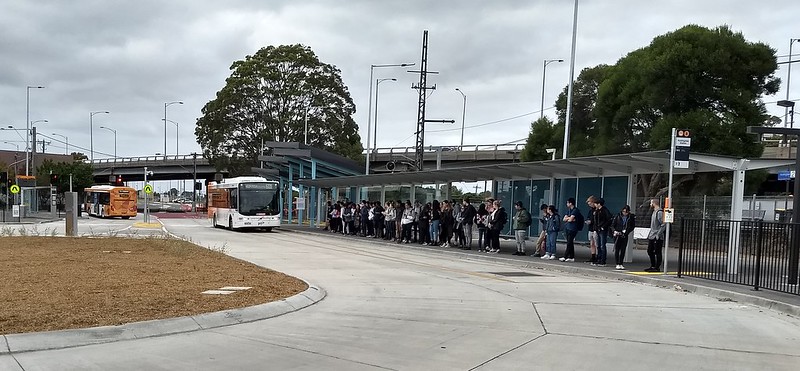
Sensibly, the 601 to Monash University has the prime spot, next to the station entrance. The 630 to Monash also stops nearby.
The 900 is over the other side. I’m betting this is to try and prevent people who just want Monash Uni swamping this service, so people going further can get onto it.
Universities Some universities don’t observe public holidays that aren’t national public holidays. Labour Day is one of these, so there were quite a few people headed to campus.
Thankfully the 601, normally a weekday-only route, also runs on such days. Other bus routes were running a Saturday timetable.
On this day, buses were replacing Cranbourne/Pakenham line trains, so passengers were actually changing off other buses. Given the large numbers of people involved, perhaps when there are rail works on university days, should they run some rail replacement buses via campus?
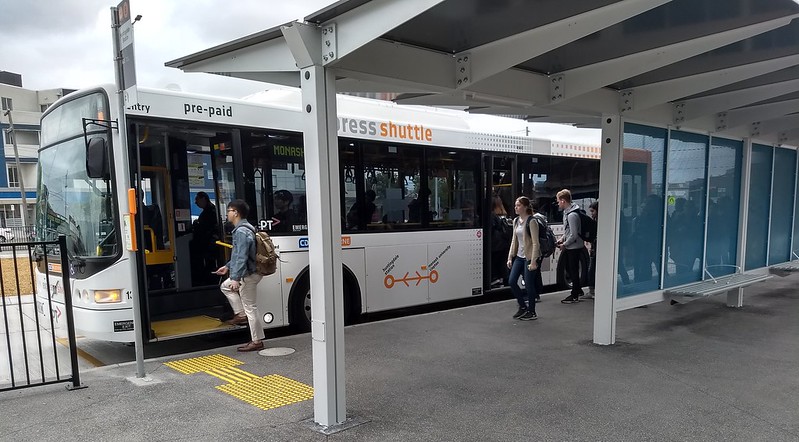
The 601 buses are prepaid-only (no Myki purchases or top-ups on-board), and board by all doors, to help speed things up. Ironically most people queuing used the back door, so it was almost as slow as boarding by just the front door.
Just as the near-full 601 completed loading and headed off, another one arrived. One of the challenges for this route is keeping buses coming through at an even frequency.
Crowds on some mornings in the past few weeks have resulted in long queues, and apparently this happens every year at the start of semester. This was the scene on 7th March (via Darren):

The long wait for a bus to campus was cited last week in The Age, with queues contributing to one campus commuter giving up on public transport. (The article reckoned she’d drive the following day. That was the day that a truck breakdown in the Burnley tunnel caused widespread disruption, so it may not have been any less painful!)
While some would like to see a rail link, the obvious short-term upgrade is more buses, even just for a few weeks when demand is highest… or bigger buses — it looks like the new interchange can handle long articulated buses, and hopefully the same can be said for the stop at Monash, and the route between them.
(Double-deck buses would also cater for more people, but have longer dwell/loading times, negating the benefit somewhat.)
Also at Huntingdale, they have installed a new style of bus stop sign. The “B” is a bay indicator, rather than a Sydney-style B for Bus.
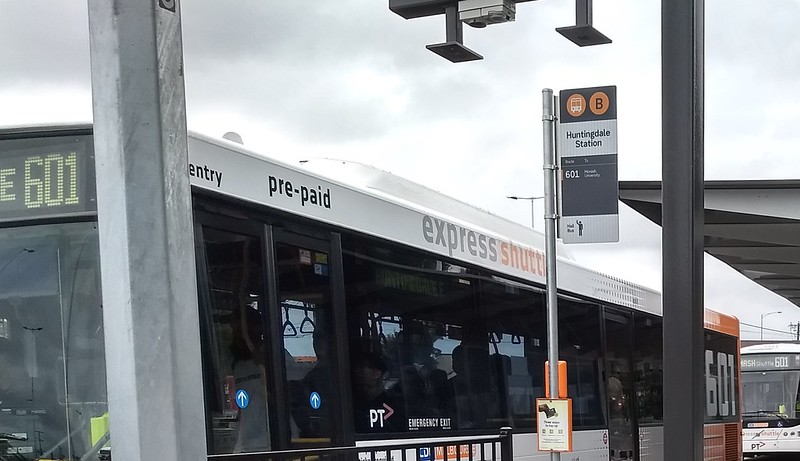
I’m surprised to see it says “Hail bus”. I wouldn’t have thought that was needed at the terminus of a point-to-point shuttle.
Note the absence of any operator or PTV or even Transport For Victoria branding.
It also looks like further (automated?) signage is coming. (Around the interchange there are also some Smartbus signs, not yet activated.)
Anyway, I kept walking and found this on North Road – a rather splendid looking brick bus shelter.
Looks like it’s a few decades old. Being north-facing it may not provide much shade, but at least unlike its newer cousins, it’s not plastered with ads, and it doesn’t block the footpath as it’s set back (onto council land).
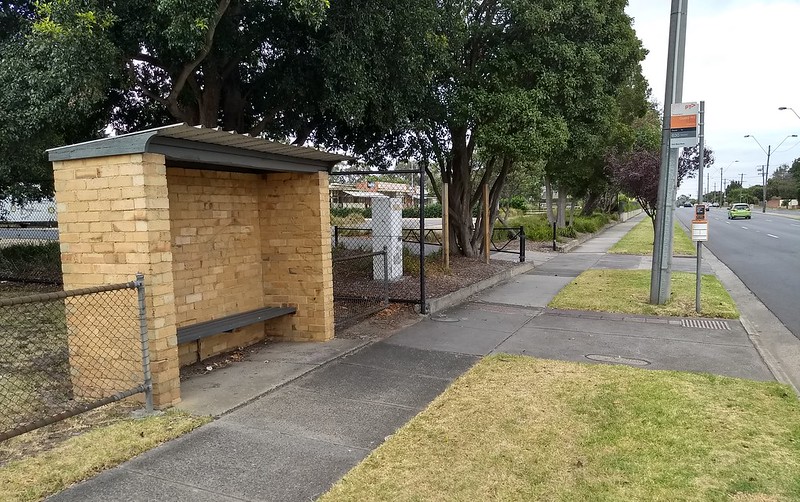
Further along, I found this stop on Warrigal Road near North Road. Someone’s forgotten to take down this old sign from the former operator, Ventura.
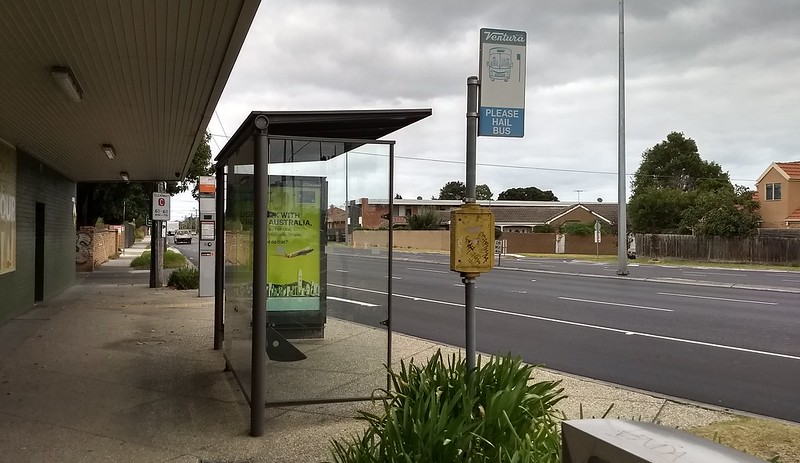
Also here: the intersection was recently resurfaced. It seems to me they missed an opportunity to provide a jump-start lane for buses. With or without a “B” priority light, it would help the busy route 630 buses get ahead of the other traffic.

Similarly, the bus jump start lane at Wellington Road/Princes Highway westbound should be made 24/7 instead of peak only. Cars clog it up outside peak times, which just seems silly.
Buses play a vital role in filling gaps between the trains and trams. The alignment along North/Wellington Road to Monash University and Rowville is a big gap.
In public transport, “software” — routes and operating hours and frequencies that meet passenger needs, is essential.
But “hardware” (infrastructure) is also important.
It’s good to see the upgrade at Huntingdale, and it’d be even better to see upgrades to the 601 service to keep up with demand.
More bus priority, especially an easy win such as at Warrigal/North Road would also be very welcome.

29 replies on “Three bus stops outside Huntingdale, Victoria”
“Universities don’t observe public holidays that aren’t national public holidays.”
Not strictly true. The public holidays universities observe is determined by their EBA, so varies a lot between universities. Monash may not observe labour day, but Federation Uni does
A good positive story. The time periods span both Coalition and Labor governments so both can take some credit.
The car is still the “only” real option for many Monash uni students due to logistics more than anything else. Or those who stay back late (e.g. 8pm sport practice). Whereas for Melbourne Uni, RMIT, etc, most students wouldn’t dream of driving in. Good, predictable, frequent, PT exists for those travelling to campuses in/near the CBD. Interchanges are much more seamless too.
The express rail replacement buses travel along Princes Hwy, so it’d be easy to stop at Princes Hwy/North Rd, with a short walk to the campus, without the route meandering too much for the rest of the passengers on board.
On a similar vein, when the Burnley group has replacement buses to/from Richmond and there’s an event on at the MCG / Rod Laver Arena etc., it’d be a good opportunity to have buses originate from Olympic Bvd before continuing to the regular Richmond stop, or allowing some buses to run express via Citylink without crawling through Swan St.
Bus shelters are a rare find in Melbourne’s west. People wait in the wind and the rain, hoping their bus will come.
I wonder why this city has far fewer than in many other cities?
The “new-style” bus stop signs have also been present on totems at the renovated Monash University bus loop since the start of 2017.
I think they’re the first stop/station name signs to use the new PTV font, after it appeared on maps, posters and the signs for toilets.
Just don’t mention the appalling mess that was made of the new “bike path” where cyclists are required to dismount and walk, because it is directed through the middle of the bus stop. Someone needs to explain to these muppets that if the only way you can build a bike path is by by prohibiting riding bikes on it then you need to revisit your design manuals. It sounds like something out of Yes Minister, but is apparently all part of the green-wash of a “continuous bike path”
Great to see all-door loading used in Victoria without inhibition, as it is on selected busy services in most states and territories except NSW, where TfNSW stubbornly refuses to allow it (except with footpath inspectors present at some CBD stops!), so we still have ridiculous dwell times on the busiest services. Have you seen the video from Boston that I’ve posted on ATDB and TDU comparing all-door and front-door loading times?
I would suggest artics with a full complement of three double doors if these services become overwhelmed. Certainly not double-deckers which are hopeless with crowds and have a smaller capacity anyway.
Loading through the centre door/s is best because it distributes the crowd into and evenly through the bus much better. I think I can see the problem in your photo – that looks like a single-leaf centre door. PTV should be setting a minimum standard of wider double-leaf doors for all buses. Another option on the 12 metre rigid buses is to have another door between the axles (three double-leaf doors in total), like the Carbridge airport shuttle buses.
Furthermore, I would recommend fully low floor chassis (stepless aisles) for buses in these very busy services as they encourage standees to spread right to the back of the bus. If you observe many crowded buses, you see that steps in the aisle create both a physical and psychological barrier causing the crowd to stick to the front half of the bus. So far, the only low-floor (as opposed to low-entry) chassis on the Australian (RHD) market at present are by Scania and MAN, but this will change as such chassis have been normal on the LHD European market for a couple of decades now.
With these enhanced methods and practices, it’s possible to squeeze more efficiency and capacity out of bus services without necessarily having to consider moving up to tram or rail.
I’ve found some bus drivers are reluctant to open the back door. The bus stops, I’m standing next to the door and nothing happens (maybe I move too quietly). Then I have to yell to please open the back door and hope they don’t drive off in the mean time. This may be why people prefer to stand near the front when there aren’t any seats left.
Would an isolated tram line from Huntingdale Station to Monash be useful? Running frequent high-capacity trams. The main drawback would be finding and acquiring land for a depot somewhere near the main route.
The current works at Huntingdale they are finishing now have provided DDA compliant access to the subway, but only from the station entrance end. The station access and other end of the subway both retain non-DDA compliant ramps. The extra $4 million seems to have been announced in conjunction with the $10 million upgrade to Oakleigh station for ramp regrading and platform lifts and presumably provides similar upgrades to the remaining non-DDA compliant access points to the subway.
I suspect that the Cailfield-Yarraman bike path will be routed through the newly upgraded Oakleigh station underpass, via another mandatory dismount section, because it is likely to need to cross the railway at Oakleigh station.
The 601 does seem perfect for articulated buses.
An isolated tram line would not be a good idea. A tram line Hungtindale-Monash would likely mean replacing the whole 630 route with a tram line, so that the existing tram network could be connected to at Hawthorn Rd.
Here is the link for the Oakleigh and extra Huntingdale upgrades.
http://stevedimopoulos.com.au/major-upgrades-for-oakleigh-huntingdale-stations/
A full fleet of artics would provide the same capacity as Z or A class trams (about 110 per bus) and would no doubt save some operating costs.
PTV needs to make a directive to all operators to open the centre door/s for exit at all times. Not opening it is one of the bad old practices that came with OMO and certainly resulted in buses blocking up with standees in the front half of the bus. I would hope at least that when all doors are opened for entry they’d also be opened for exit.
That first photo looks like the original Ringwood bus interchange before the government completely stuffed it up.
Now half the buses, including the 901 SmartBus, sit on the edge of Maroondah Highway while a small handful use the old interchange, and they all have to perform a loop-de-loop around Ringwood station because they reversed the entry/exit points, and they didn’t even think of using the extra land for the buses (or even car parking for that matter) after the nearby 60s-era eyesore buildings were flattened. Not only that, the new interchange did away with the zebra crossing and had pedestrian lights installed – yes, beg buttons – just to cross the bus bay outside Ringwood station’s platform 3 entrance. And then of course, more useless two-minute lights (or are they 90 seconds) at Maroondah Highway because they couldn’t be stuffed bridging the gap between the station and Eastland/Realm.
Regarding bus loading times, in Brisbane, I believe they trialled having external card readers at bus stops to quicken boarding though I am not sure what the outcome was as this was years ago.
In the context of Melbourne, I know it might seem impractical as the operator will have to switch the reader to register the cards to the service that the passengers are currently boarding, but then again, I’ve noticed that at bus interchanges near train stations, each stop only seems to serve one service.
Of course, one of the things I can’t understand is that there are two myki readers at the rear door while there is only one at the front.
Monash are pushing for CDC to introduce articulated buses on the 601. The new interchange on campus has plenty of room to accomodate this.
Increasing frequency isn’t really practical, bigger buses are the only solution.
Nice report Daniel it is better then nothing and big improvement for the 601 situation of having to cross the road.
Does the 900 bus eastbound stop in the new stop? Because it is a constant issue where the 900 eastbound bus is so far removed from the train station that it leaves before passengers from the train can make it to the stop on the other side of the road.
You’re right in saying the Wellington/North corridor could. The 900 bus from Rowville has as of Febuary increased to a 10min frequency in peak hour (much needed) but it hasn’t been well advertised. Bus priority has started but most buses still still gets caught in traffic east of the Monash Freeway overpass on Wellington road (because of the merge back to 2 lanes and the fact that there is a poorly designed bus stop where the bus has to sit in the freeway on ramp traffic lane while the main traffic keeps moving.
There is still a long way to go because it is still quicker most mornings for me to to ride my bike (~13km) in peak hour from Rowville to Huntingdale than catch the bus which it just shouldn’t be.
So small improvements with a long way to go.
Monash staff (of which I am one) and students don’t observe Labour Day, Queen’s Birthday and Melbourne Cup Day.
I would like to see the normal weekday timetables observed on the Pakenham/Cranbourne line on those days. Monash is a very large employer with many staff and students at Clayton and Caulfield – many use that rail line and it seems as busy on those holidays as normal working days. I always feel for the students who are trying to get to exams on Cup Day (mostly at Caulfield race course) and have to contend with the reduced frequency of services.
This – and note the double-leaf doors, enabling two-abreast or at least zipper loading and unloading:
None of our universities are well served by the rail system, but are significant destinations – so the express shuttle services are good additions. I used to work at Melbourne University when the 401 from North Melbourne was introduced – prior to that I took the 402 from Footscray rather than train/tram via Melbourne Central. Presumably the 401 and the newer 403 will disappear when the Metro Tunnel opens.
I imagine the universities such as Monash, La Trobe and Deakin also need good orbital services. I was lucky enough to live on campus at La Trobe when I studied in the early 90s, so didn’t have to worry about getting there – but you had the ring of car parks around the campus suggesting car was (and probably still is) king – even though there was a bus and tram from the city, and (probably not all that regular) bus services from the Epping and Hurstbridge lines.
I’ve also had some involvement with Deakin in recent times – it can take longer to get to the Burwood campus than it does to get to the Geelong Waterfront campus!
The issue of how many doors open reminds me of Canberra, where the rear doors are only opened at the town centre interchanges.
The 401 may still be needed for Craigieburn and Upfield line passengers, as they will have no direct access to the new tunnel before Melbourne Central.
The 403 may well be surplus to requirements after the new tunnel opens.
The university campuses in the CBD (RMIT and many small campuses), Monash Caulfield and VU Footscray are well served by the rail network.
It is a shame that the Mont Park branch line (from Macleod) was closed rather than extended to Latrobe University.
The Rail Futures Institute, are pushing for an extention of the tram network, to run all the way along North Road and Wellington Road via Ormond and Monash University, and on to Rowville.
The 601 stops at the new interchanges (Huntingdale and Monash) are long enough for articulated buses. I hope they will actually come in at some point.
I suppose the consideration for the operator is that the service is busy for no more than half the year (26 weeks). And, as any university student (or staff) would tell you, the university is significantly emptier a few weeks into the semester – although it seems like week 5 of the semester at Monash now is the same as week 1 a few weeks ago.
The new interchange presumably provides a more articulated bus friendly means of turning from Huntingdale Rd into the access to North Rd than the previous rather sharp right turn in general traffic.
The buses should be able to reasonably cope with the peak of normal patronage at the start of semester. That might even help keep some students attending more of their classes.
The new interchange should allow city-bound rail replacement buses to turn back into North Rd westbound and then via either Golf Links Avenue and Bank St (like the outbound replacement buses) or Clarendon Avenue to Haughton Avenue and then to Oakleigh, rather than the current circuitous route via Huntingdale Rd, Atherton Rd, Warrigal Rd and Mill Rd. This had not happened when I last went on the replacement buses, even though the new interchange was open.
[…] in this style were also installed at the new Huntingdale bus interchange earlier this year. (“Hail bus”? […]
I don’t really like the blue colour scheme they’ve gone for at Huntingdale, perhaps orange would be better.
[…] the whisper is that the branding already seen on the Mernda line extension and the Huntingdale and Monash bus interchanges shows the way forward – most signs with no operator […]
@Luke, yes the 900 to Rowville stops in the bus loop as well, its stop is placed just next to the 900 to Caulfield’s stop.
I think they made the 180° turn at the back of the bus loop a bit too tight – I occasionally see buses hitting the kerb there as they attempt to make the turn.
Placing the 601 and 630 to Monash on the same side was a great idea, giving you options for either route to the University. I often see a lot of people standing in line for a 601 while a 630 to Monash is parked in the adjacent bay, waiting with its doors open! Amusingly, both are timed as 7 minutes from Huntingdale Station to Monash Uni on the timetable.
@Tom: To be fair, the Mont Park Line closed a few years before La Trobe University opened, although the site was chosen the same year it closed (1964). I guess, as a shuttle, it would’ve worked, although Macleod Station would likely need some upgrading!